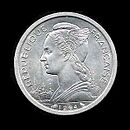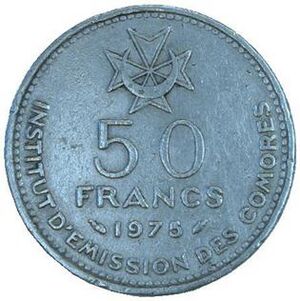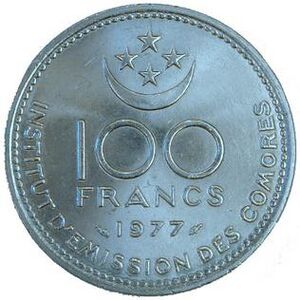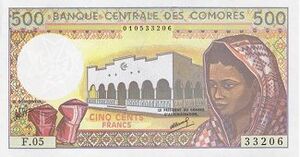Comorian franc facts for kids
Quick facts for kids Comorian franc |
|
|---|---|
| ISO 4217 Code | KMF |
| User(s) | |
| Inflation | 6.3% |
| Source | The World Factbook, 2012 est. |
| Pegged with | euro = 491.96775 francs |
| Subunit | |
| 1⁄100 | centime no longer used |
| Symbol | FC |
| Coins | |
| Freq. used | 25 FC, 50 FC, 100 FC, 250 FC |
| Rarely used | 1 FC, 2 FC, 5 FC, 10 FC |
| Banknotes | 500 FC, 1,000 FC, 2,000 FC, 5,000 FC, 10,000 FC |
| Printer | Banque de France |
The Comorian franc (sign: FC; ISO 4217 code: KMF) is the official money used in the country of Comoros. It is also known as franc comorien in French and فرنك قمري in Arabic. Even though it's supposed to be divided into 100 centimes, no centime coins have ever been made.
Contents
History of the Comorian Franc
The French franc became the money of Comoros in 1886. This happened after the islands became a French protectorate. A protectorate means a country is protected and partly controlled by another, stronger country.
In 1891, the local ruler, Sultan Said Ali bin Said Omar of Grande Comore, made his own coins. These coins were in centimes and francs. They were used alongside the French money. In 1912, Comoros became part of Madagascar, which was also controlled by France. French money was then used throughout the area.
In 1925, a special bank called the Banque de Madagascar was created. This bank had the only right to print money for Madagascar. The money it printed was called the Malagasy franc. It had the same value as the French franc. French coins were still used because Madagascar didn't have its own coins until 1943.
When Comoros became a separate French territory in 1945, the bank's name changed. It became the Banque de Madagascar et des Comores. A branch of this bank opened in Comoros in 1953. The banknotes were updated for Comoros, but the coins still only showed the name Madagascar. In December 1945, a new currency, the Madagascar-Comores CFA franc, was set up. Its value was fixed to the French franc.
In 1960, Madagascar became independent from France. A new bank was created to print money only for Madagascar. Madagascar stopped using the CFA franc in 1973.
In 1979, Comoros made a special agreement with France. This agreement made the Comorian franc part of the "franc zone." This meant the Comorian franc had a fixed value compared to the French franc. It also meant you could freely change one currency for the other. France helped guarantee this system. Most of Comoros' foreign money is kept in a special account in France.
The Comorian franc stays stable because of strict rules. For example, the central bank must keep enough foreign money. Also, the government cannot borrow too much from the central bank.
Until 1994, 50 Comorian francs were equal to 1 French franc. But on January 12, 1994, the Comorian franc's value was changed. It became 75 Comorian francs for 1 French franc. This is called a devaluation, meaning its value went down. When the euro currency was created in 1999, the Comorian franc was then linked to the euro. Today, 1 euro is worth 491.96775 Comorian francs.
How the Euro Zone Affects the Comorian Franc
When the euro was being created in 1998, European leaders looked at France's money agreements. They decided that:
- The agreements would not affect the euro's value or money rules.
- The agreements would not stop the euro zone from working well.
- The European Central Bank (ECB) would not have to support the Comorian franc.
- France would still guarantee that the euro and Comorian franc could be exchanged at a fixed rate.
- French officials must tell the European Union about these agreements. They must also tell them before changing the value of the Comorian franc against the euro.
- Any big changes to these agreements would need approval from the European Union.
The Central Bank of Comoros
The Banque Centrale des Comores (Central Bank of the Comoros) is the main bank in the country. It controls the money supply. Its board of directors has eight members. These members come from the Comorian Government, the French Central Bank, and the French government.
A French official from the Banque de France holds the job of deputy director. This person helps manage the money rules. Since 1999, the bank's interest rates have been linked to the Euro Overnight Index Average (EONIA). This helps keep interest rates stable compared to the euro. The bank also makes sure other banks keep a certain amount of money in reserve. The main office is in Moroni.
Coins of Comoros
In 1890, Sultan Said Ali made the first Comorian coins. These were bronze 5 and 10 centimes and silver 5 francs. They were made in Paris, France. These coins were officially stopped in 1912, but some were still used until the 1930s. The bronze coins are sometimes used for special cultural purposes. All three coins had the date 1308 AH, which means 1890/91 AD.
In the 1920s, there weren't enough coins. So, some companies made their own special tokens. These included 25 and 50 centimes, and 1 and 2 francs. They were made from aluminum and bronze.
New coins made just for Comoros were introduced in 1964. These replaced the old Madagascar coins. They included aluminum 1, 2, and 5 franc coins. There were also aluminum-bronze 10 and 20 franc coins. Later, in 1975, nickel 50 franc coins were made. Nickel 100 franc coins followed in 1977, and nickel 25 franc coins in 1981. After 1990, nickel-plated steel was used instead of pure nickel.
Until 1975, only French words were on Comorian coins. Since then, the Comorian language has also been used.
| Coins of the Comorian franc | |||||
|---|---|---|---|---|---|
| Obverse | Reverse | Denomination | Weight (grams) | Diameter | Composition |
| 1 franc | 23 mm | aluminum | |||
 |
2 francs | 2.2 | 27 mm | aluminum | |
| 5 francs | 3.75 | 31 mm | aluminum | ||
| 10 francs | 22 mm | aluminum bronze | |||
| 25 francs | 3.9 | 20 mm | nickel | ||
| 50 francs | 6 | 24 mm | nickel | ||
| 100 francs | 10 | 28 mm | nickel-plated steel | ||
Comorian coins are made by the Monnaie de Paris in France. You can often see a special mark, a cornucopia, on the coins. This mark shows where they were made.
Some coins have nicknames:
- The 5 franc coin is called reali.
- The 2 franc coin is called nusu, meaning "half."
- The 1 franc coin is called "robo," meaning "quarter."
The 1, 2, 5, and 10 franc coins are not used much today because their value is very low. The 25 and 100 franc coins have a phrase: "Augmentons la production alimentaire." This means "Let's increase food production." The 5 franc coin says: "Conférence Mondiale sur les Pêches," which means "World Conference on Fishing." These phrases are related to programs from the United Nations Food and Agriculture Organization (FAO). Comoros is one of many countries that have made FAO coins.
Banknotes of Comoros
The first paper money in Comoros was issued in 1920. These were actually postage stamps stuck onto cards. They were used as money because there was a shortage of coins. They came in values of 50 centimes and 1 franc.
Later, starting in 1962, banknotes from the Banque de Madagascar et des Comores were used. These notes had the word "COMORES" stamped on them. The values were 50, 100, 500, 1,000, and 5,000 francs. Notes without this stamp stopped being legal money by the end of 1964.
The stamped notes were used until 1976. Then, new 500, 1,000, and 5,000 franc notes were introduced. The 50 and 100 franc notes were replaced by coins. The Central Bank started printing money in 1984. In 1997, 2,500 and 10,000 franc notes were made. A 2,000 franc note came out in 2005. The 2,500 franc note was stopped on January 31, 2007.
Comorian banknotes are printed in France by the Banque de France. Modern banknotes, like those from 2005 and 2006, have special security features. These include the EURion constellation, which is a pattern that helps prevent counterfeiting.
All Comorian franc banknotes
Exchange rates
| Current KMF exchange rates | |
|---|---|
| From Google Finance: | AUD CAD CHF EUR GBP HKD JPY USD EUR JPY USD |
| From Yahoo! Finance: | AUD CAD CHF EUR GBP HKD JPY USD EUR JPY USD |
| From XE.com: | AUD CAD CHF EUR GBP HKD JPY USD EUR JPY USD |
| From OANDA: | AUD CAD CHF EUR GBP HKD JPY USD EUR JPY USD |
| From fxtop.com: | AUD CAD CHF EUR GBP HKD JPY USD EUR JPY USD |
See also
|
|




